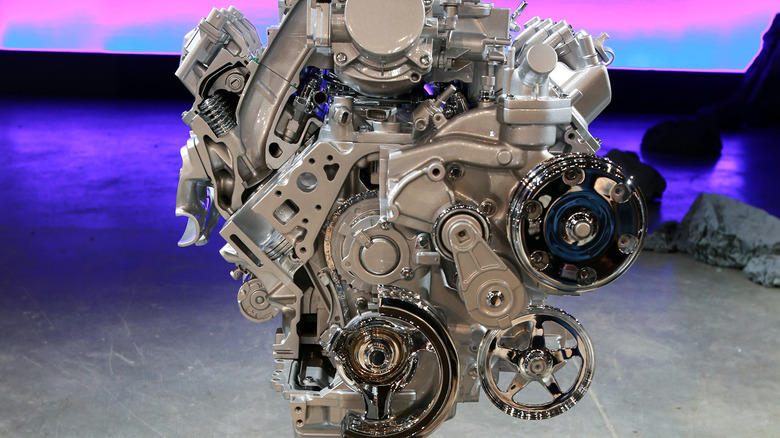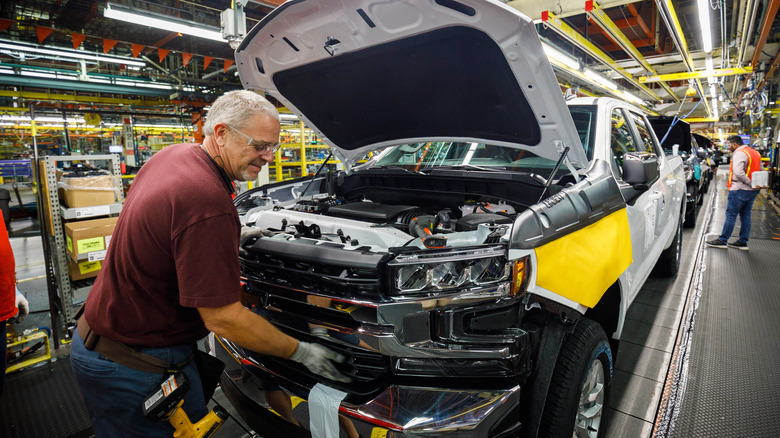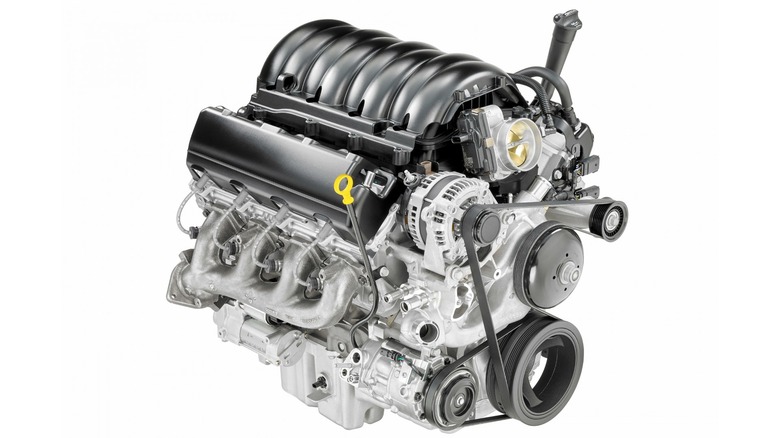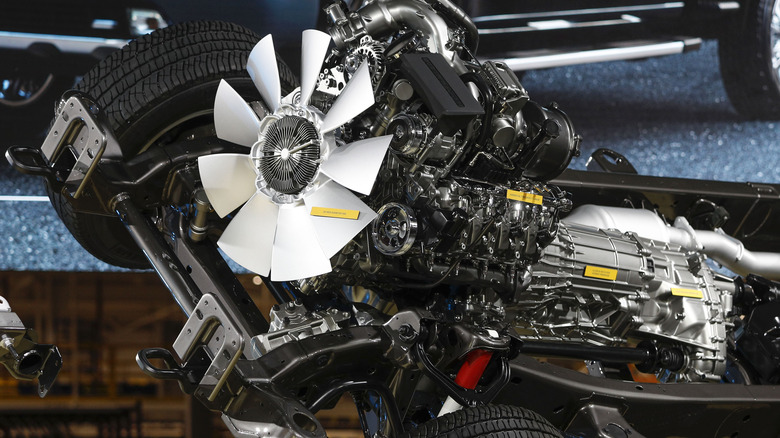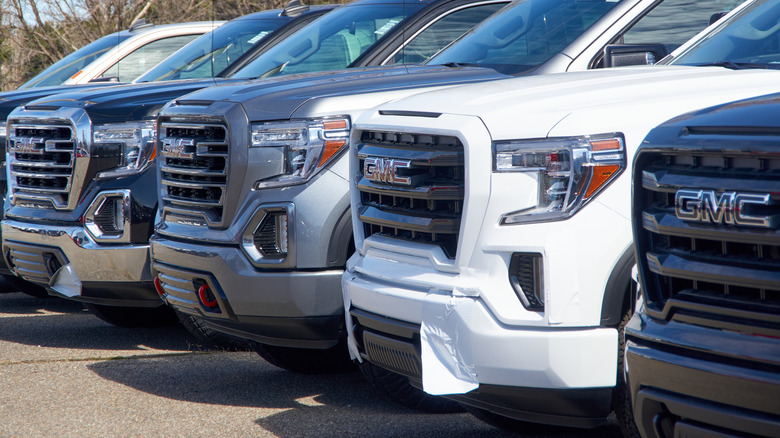A Quick Guide To GM's Ecotec3 5.3L V8 Engine: What You Need To Know
Automotive engine technology has come a long way since Carl Benz put a one-cylinder 2/3 horsepower engine on the Patent Motorwagen in the late 19th century. Modern engines are cleaner-burning, highly efficient, and more powerful per unit of displacement than ever before. This is due to a combination of lighter materials, tighter sealing, and advanced testing and development processes that allow automakers to wring the most from every drop of fuel.
General Motors — founded by William Durant in 1908 — developed the LS series of engines beginning in the late 1990s. Those engines have become popular for their ability to be upgraded and installed in a variety of vehicles, from vintage Jeeps and muscle cars to 1970s vehicles ranging from a Mazda RX2 to an AMC Pacer and an Austin Mini.
The LS line then gave way to GM's Ecotec series of engines, which the manufacturer handed the LT and L8 designations. Among them are the L83 and L8B 5.3-liter V8s — the L8B has GM's mild hybrid eAssist system, which it claims offers a fuel economy increase of up to 13% over the L83 version. The L83 Ecotec 5.3L V8 is available in a handful of 2014–2019 Chevrolet and GMC pickups and SUVs. Let's look at everything we know about this powerful and efficient motor.
Vehicle applications
General Motors put the 5.3-liter Ecotec V8 in several of its trucks and SUVs between 2014 and 2019. It was available in Chevy Silverado and GMC Sierra pickups from 2014 through 2018 and in Chevy Tahoe, Suburban, Yukon, and Yukon XL SUVs between 2015 and 2019. The 2018 and 2019 model year Tahoes were available with a 10-speed transmission; all other vehicles had their Ecotec V8s mated to a Hydra-Matic six- or eight-speed gearbox.
Those drivetrains helped the 2018 model year Tahoe and Silverado earn a spot on Kelley Blue Book's list of vehicles with the best resale values. The Silverado took top honors that year in the full-size pickup category, and the Tahoe won among all full-size SUVs and crossovers.
In a press release, Chevy's Director of Marketing, Sandor PIszar, mentioned the brand's long history while looking to the future. "Chevrolet recently celebrated 100 years as a truck maker," he said. "We've built more than 85 million dependable, long-lasting pickups with an emphasis on quality, which will continue to be an integral focus for our lineup moving forward."
Operation and specs
The 5.3-liter Ecotec V8 produces 355 horsepower and 383 pound-feet of torque while providing fuel economy of 23 mpg highway in 2WD applications. These power output and fuel consumption numbers are both substantial improvements over the 5.3-liter LS series motor, which powered various Chevrolet, GMC, and Buick models between 2005 and 2014.
The block, heads, and pistons are made of aluminum to save weight, and the cylinder walls are reinforced with a cast iron lining. The Ecotec engine uses direct injection technology, which precisely meters the amount of fuel that is delivered to each cylinder according to load, engine temperature, and other conditions. The L83 5.3-liter Ecotec engine also saves fuel by switching to four-cylinder operation when demand allows.
General Motors put the engine through 10 million hours of computer testing simulations, six million hours of which were spent on the fuel delivery systems. Jordan Lee, GM engineer and manager of the small block engine program, highlighted the active fuel management system in an interview with GM Authority.
"GM pioneered cylinder deactivation technology, and we consider it a great technology for improving the efficiency of full-size trucks," Lee said. "This is another great example of using a relatively simple mechanical system and powerful software to provide a real benefit to our customers."
Common issues
One of the 5.3-liter Ecotec 3 engine's high-tech features, while it can contribute to fuel savings, has also led to some of the engine's common problems. Direct injection is a technology where the fuel is introduced into the combustion chamber of the engine's cylinders directly and not via the cylinder head's intake valves. While this allows for precise fuel metering, the flow of fuel through the valve system helps keep the valvetrain clear of carbon buildup.
Without this cleaning action, deposits of oil and unburned fuel can build up in the intake ports and cylinders, causing loss of power and fuel economy and rough idling. The best way to clean these deposits is to remove the intake manifold and clean the ports with crushed walnut shells, a process known as walnut blasting.
Direct injection also requires a fuel pump that operates at very high pressures, sometimes up to 1,500 psi. (By contrast, a 2000 5.3-liter LS series engine requires about 50–60 psi of fuel pressure.) This high demand can lead to pump failure. Direct injectors are also subjected to very high heat inside the cylinders and can often fail and stop delivering fuel, leading to a cylinder misfire.
Class-action lawsuit
Problems with the valvetrain and active fuel management system in the 5.3-liter Ecotec engine have led to a class-action lawsuit against General Motors. In 2021, nine plaintiffs filed a suit in the U.S. District Court that covers Eastern Michigan, alleging that GM used low-quality materials and a faulty design in the engine's valve system and active fuel management system components. The suit also claims that the lifters were installed incorrectly and that GM used substandard quality parts as replacements when buyers complained about failures.
According to Top Class Actions, disgruntled customers claimed the defective systems posed a hazard to their safety. "The Valve Train Defect can leave drivers and passengers in dangerous situations," the suit read. "For example, stalling, losing power while driving, and hesitation, especially when trying to merge, increase the risk of a traffic collision."
The suit also covered 6.0 and 6.2-liter V8 engines with the same technology and called for GM to issue a recall on affected vehicles, something the automaker never did. GM did extend the warranty on some affected vehicles but offered free repairs only after owners had brought their vehicles in after two failures related to the system. One vehicle suffered a lifter collapse after just 8,250 miles. This past February, Judge Laurie Michelson sent 17 of the 20 plaintiffs' suits to arbitration as required by their dealer purchase agreements.
Despite these issues, many owners are satisfied
Although the problems with this engine are well-documented, there are plenty of accounts of owners who are quite happy with the performance and durability of their 5.3-liter Ecotec-powered GM vehicles. If properly maintained, these trucks and SUVs can run for as much as 200,000 miles.
One key is keeping the intake manifold and cylinder walls free of carbon deposits, which can be done with regular walnut blasting or wire brush cleaning. Using high-quality fuel can also help keep these engines running well for a long time. Dealers also recommend changing spark plugs regularly to keep fuel combustion robust and cylinder walls clean.
One owner of a 2018 Sierra pickup who is also responsible for monitoring the repair history of his company's fleet of vehicles posted to GM's Silverado and Sierra Truck Talk forum reporting on how reliable his company's 210 GM trucks had been over time.
According to the poster, known only as "PSO," only one of those 210 trucks had experienced an engine-related failure; that was a problem with the automatic fuel management system. The rest of the work orders he reviewed were for normal wear items like brakes and tires, although other vehicles required vacuum pump or ignition coil replacements, and at least one had its transmission replaced under warranty.
